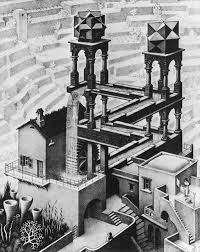| |
How close can we get to absolute zero?

The Third Law of thermodynamics defines the absolute temperature scale. There are many important implications of this definition. For example, one cannot devise a perpetual motion machine! Thermodynamic efficiency is 100% only at absolute zero, but we cannot get to absolute zero. Therefore, we cannot build a perpetual motion machine. The picture on the left by M.C. Escher shows an artists picture of a perpetual motion machine. Escher was a genius of optical illustion and the machine is obviously an illusion and not real. For research into what the Third Law means we need to get to very cold temperatures. This is done using a technique known as magnetic refrigeration. Shown in the title art for this page you can see the process of isothermal magnetization followed by adibatic demagnetization, which is a cooling step. Repeated application of this process leads to cooling below the temperature of 3He, which is the coolest one can get to otherwise. The normal isotope of He is 4He, which has a boiling temperature of about 4 K. Using pumped 3He we can achieve 0.3 K. Below that we must use the techniques shown above.
The Third Law and residual entropy
The Third Law states that all perfect crystalline substrances have an entropy S = 0 at T = 0 K. A corollary is the Cp approaches zero as T apporaches zero as well. It is perhaps better to use the wording "approaches" since we cannot actally achieve T = 0 K. We can get very close using the methods discussed above. We just cannot get all the way there. Based on experiments at low temperature and the statistical theory of entropy we know that the entropy of imperfect crystals is not zero at T = 0 K. Instead, there is an entropy due to the statistical distribution of possible structures. For carbon monoxide that uncertainty arises from the possibility that each CO enters the lattice as CO or OC. The energy difference is so small that we can observed 2 possible conformations for each CO and W = 2N possible configurations for a system of N molecules. The statistical entropy is S = kB ln(W) so that becomes S = R ln(2) for a mole of CO molecules. We call this entropy the residual entropy.
Absolute Entropy
The entropy at absolute zero may be zero or may have a small residual value. Either way it is an absolute. This means that we can start at T = 0 K (or very close to that temperature) and integrate up to a higher temperature to achieve an entropy for a substance. These entropies are tabulated as absolute entropys So. This is quite different from enthalpy where so absolute value exists. For enthalpy, please recall that we defined a reference value of Delta Ho = 0 for elemental compounds in their most stable forms at 298 K. This definition is a convenient one, but it is not absolute and it is not unique. Entropy is different. We have absolute entropies. However, the entropy of reaction is calculated using a method analogous to the enthalpy of reaction, meaning that we use the tabulated values for entropies of products multiplied by stoihiometric coefficients times reactants time their stoichiometric coefficients to obtain the Delta S of reaction.
References
Artwork on this page. "Adiagatic demagnetization" from C. Rose-Petruk, Brown University, 7-an 1999 (on left) and magnetic refrigerator (on right) "Magnetocaloric effect1 04a" by Mtodorov 69 (original); Pbroks13 Original uploader was Pbroks13 at en.wikipedia - Transferred from en.wikipedia; transfered to Commons by User:Pbroks13 using CommonsHelper.(Original text : en::Image:Magnetocaloric effect1.04a.png). Licensed under CC BY-SA 3.0 via Wikimedia Commons - http://commons.wikimedia.org/wiki/File:Magnetocaloric_effect1_04a.svg#/media/File:Magnetocaloric_effect1_04a.svg
| |
|
|
|